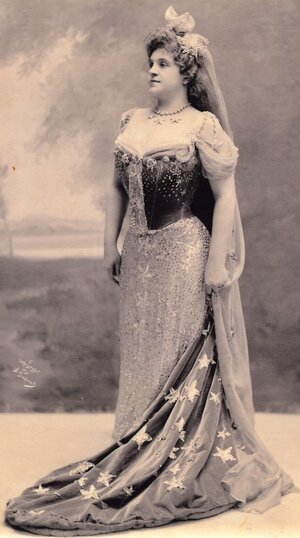Marcella Sembrich
née Prakseda Marcellina Kochanska
February 15, 1858 – January 11, 1935
“It was not only the voice that thrilled, — it was the noble and lofty art that guided it. It was the musicianship that lay behind it — it was the glow of emotion ever present yet superbly controlled that enriched it — and the beautiful womanhood permeating all, that ennobled it.”
-- R. Goldmark (Composer, Pianist, Teacher of George Gershwin)
Marcella Sembrich was one of the most prolific musicians and teachers of the late 19th and early 20th centuries. Her long career included lead roles in the opening season of The Metropolitan Opera and operatic, recital, and concert appearances across Europe and the United States.
Marcella Sembrich (ca. 1912). From The Sembrich Collection
Born into poverty in the Polish region of Austro-Hungarian occupied Galicia, she showed great promise as a violinist and pianist. The young Sembrich earned money to support her family and pay for studies at the Lviv Conservatory (then in Austro-Hungarian Galicia, now in Ukraine) by playing for parties of nobility. She eventually earned enough to attend the Vienna Conservatory, where she studied piano, violin, and eventually voice. She made her operatic debut in Athens in 1877 in the title role of Donizetti’s Lucia di Lammermoor. This same year, she married her mentor and advocate, pianist Wilhelm Stengel, gave birth to the first of two sons, and made her permanent home in Dresden.
In 1883, Henry Abbey, the manager of the fledgling Metropolitan Opera Company, offered Sembrich a contract for the company’s opening season. She accepted and sang on the second evening of the season in the title role of Donizetti’s Lucia di Lammermoor. Sembrich went on to premiere numerous roles with the company including The Queen of the Night (The Magic Flute), Mimi (La Bohème), Violetta (La Traviata), and Gilda (Rigoletto), among several others. As an artist she was a titanic figure among the company’s roster, attracting large audiences and garnering praise from many notable United States critics. She would go on to sing 466 performances with The Metropolitan Opera.
Sembrich and Wilhelm Stengel (ca. 1877) From The Sembrich Collection.
For the next three decades, Sembrich traveled across the United States and Europe singing in major cities including Dresden, London, Madrid, Paris, and Saint Petersburg. She sang alongside renowned singers such as Enrico Caruso, Christine Nilsson, Lillian Nordica, Adelina Patti, and Antonio Scotti. She won numerous curtain calls on stages including Dresden’s Royal Opera House, London’s Covent Garden, Madrid’s Teatro Real, and Saint Petersburg’s Imperial Italian Opera.
Following her retirement from the operatic stage in 1909, Sembrich came to dominate the concert stage in both the United States and across Europe. Sembrich spent almost a decade touring as a concert singer, expanding the format of the song recital. She is one of the first singers of international repute to begin including folk songs on her song recitals, a tradition that remains alive today.
After her retirement, Sembrich spent summers at her estate “Le Verger” in Switzerland, then in 1913, purchased “Villa Monticello” a new estate in Nice, France. The following summer, due to the outbreak of World War I, Sembrich left Europe and settled in the United States. She and her family took up residence in New York City and, finding solace and inspiration in the beauty of the Adirondack Mountains, spent summers in Lake Placid, New York. In the fall of 1915, Sembrich founded the American Polish Relief Committee, raising thousands of dollars and sending needed supplies to those in Poland affected by the war.
Sembrich as “Queen of the Night” (ca. 1900). A. Dupont. From the Sembrich Collection.
Sembrich retired from public life after her husband’s death in May of 1917, and continued to spend summers in the Adirondacks. Sembrich became a naturalized United States citizen in 1920. In 1922, she purchased a 55-acre estate on Lake George and built a teaching studio. Today, 4.5 acres of the original estate, including the teaching studio, are home to The Sembrich.
In 1924, both the Juilliard Graduate School and Curtis Institute of Music were founded and Sembrich was named Director of both vocal programs. Sembrich’s influence now extended from her contributions on the stage to the shaping of the musical culture in America. She brought students from both programs to study during her summers in Bolton Landing. Her students would go on to become leading singers and teachers in the United States and Europe. Curtis conferred an honorary doctorate to Sembrich at its first commencement ceremony, only a decade after its founding. In 1935, following a prolonged illness, Marcella Sembrich passed away just before her 77th birthday.
Sembrich at the first commencement ceremony for the Curtis Institute of Music (1934). From The Sembrich Collection.
In a memorial address given on January 27, 1935, Ernest Hutcheson, Dean of the Juilliard Graduate School, wrote: “But I confidently invoke that spiritual grace to be with us today, joining our minds and hearts in love and honor of a surpassing musician and interpreter of song, a noble woman, a warm and faithful friend, a tireless priestess at the altar of beauty, a spirit akin to the sun that she loved when it was high, which setting still bathes the peaks of our horizon in color and glory. This is the picture we retain, this the knowledge and memory we shall always cherish of Marcella Sembrich.”





